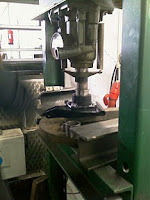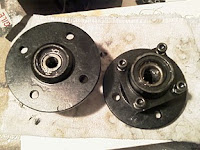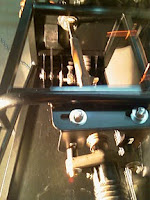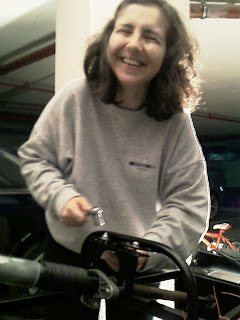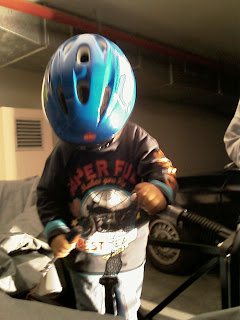Today I went around the car marking places where I have to drill to attach the p-clips with rivets. These p-clips will hold the brake oil and fuel pipes in place. I had the idea that I should have 100mm between p-clips. If so, I don't have enough to hold the fuel line.
Asked on the locostbuilders forum and created panic as it seems most people say 300mm between p-clips and only one mentioned 150mm. Some even say that the UK Individual Vehicle Approval legislation only states that it must be tightly into place.
So, no drilling was performed and I'll send an email to Steve asking him about distances as he surely knows the right answer.
Anyway, after marking the drilling spots and counting the p-clips, as I hadn't much time left, grabbed some of the aluminium body parts and laid them in place. That reminded me of several facts... I really shouldn't have assembled the steering column, it will have to go out. I have to buy tools to cut holes on the aluminium panels. All but one required holes: for the steering column, hand brake lever, gear lever, reverse box lever...
No pictures today; who would be interested in seeing pieces of masking tape on my chassis? ;)
Build diary for my first kit car: an Aries Locoblade (http://www.ariesmotorsport.com/) that I will be building in Portugal for the next months (or years).
Saturday, October 30, 2010
Saturday, October 23, 2010
Rear Uprights On The Car
Started the work session with a grinding tip on my driller to enlarge the suspension support bracket hole. After some 30m of grinding, trying to fit, removing suspension arm and repeating, it got done.
Next step was to fit the hub carrier on the suspension arms. It seemed pretty hard to make it all fit but then I thought about putting some lithium grease and that helped. The upright was in place and I read again Steve's email to be sure of the following step. And although Steve wrote twice that I should be sure I was putting the hub carrier with the straight side and the caliper support holes to the front, I did it wrong. So, I had to remove the hub carrier from the suspension arm. This all was 30m more.
Fought with the correct hub carrier on that arm but wasn't able to get it in. So I went to the other side and did the other one in around half-hour, including fitting the outer c/v joint. I had to put some wood as support bellow otherwise the arms would go down on the hub weight and the outer c/v seemed to be in strain against the lower suspension arm.
I then went back to the driver's side (left side) and gave another go fitting the hub carrier on the suspension. It was harder than the right side but it eventually got hammered into place and that side got done too.
The 2€ rubber mallet I bought on the chinese shop is proving to be one of the most helpful tools on my tool-stand. I can hammer stuff around without damaging anything (aside from the mallet itself). I did damaged a bit the thread on one of the rods that hold the lower part of the hub in place. It will put on a fight now to screw the nut into place.
I still haven't screwed any nuts in. I'm still wondering if I should put "loctite" or not, since all the nuts have nylocs.
Next step was to fit the hub carrier on the suspension arms. It seemed pretty hard to make it all fit but then I thought about putting some lithium grease and that helped. The upright was in place and I read again Steve's email to be sure of the following step. And although Steve wrote twice that I should be sure I was putting the hub carrier with the straight side and the caliper support holes to the front, I did it wrong. So, I had to remove the hub carrier from the suspension arm. This all was 30m more.
Fought with the correct hub carrier on that arm but wasn't able to get it in. So I went to the other side and did the other one in around half-hour, including fitting the outer c/v joint. I had to put some wood as support bellow otherwise the arms would go down on the hub weight and the outer c/v seemed to be in strain against the lower suspension arm.
I then went back to the driver's side (left side) and gave another go fitting the hub carrier on the suspension. It was harder than the right side but it eventually got hammered into place and that side got done too.
The 2€ rubber mallet I bought on the chinese shop is proving to be one of the most helpful tools on my tool-stand. I can hammer stuff around without damaging anything (aside from the mallet itself). I did damaged a bit the thread on one of the rods that hold the lower part of the hub in place. It will put on a fight now to screw the nut into place.
I still haven't screwed any nuts in. I'm still wondering if I should put "loctite" or not, since all the nuts have nylocs.
Sunday, October 17, 2010
Rear Uprights, Flanges and Suspension Arms
Today I managed to get 3h30m around the car. My longest stretch since my vacations ended. I'm a very happy builder today!
I started by preparing the flanges to be fitted on the hub carriers. It was mostly a cleaning job. Before I tried to fit a flange on a hub carrier, I tried to fit the studs on the flange. Ends up the studs don't go fully in and there is a gap. I believe that is not right, so I used emery cloth on the inside of the holes. It still wasn't enough... I'll have to look into it later. At least I checked that I can put the studs in after the flange is attached to the hub carrier...
... So I went to that step. Followed carefully the instructions Steve from Aries wrote me on the long and detailed email he sent me in September, when I asked about the wheel bearings. It was a really easy job. Used a bit the hammer and a kind of screwdriver to hammer softly the upper wheel bearing helping the flange to sit into place.
With both flanges inserted, I did the cleaning and preparing of the outer C/V joints. It took a bit but was another easy job.
Since Steve's email stated that I should fit the rear uprights on the chassis prior to fitting the outer CV joints, I moved on to that task. The bag with bolts, washers and nuts contained 2 shorter bolts that were marked with masking tape but without any label. Fortunately, it was easy to understand that they should go on the lower suspension arm, where if I fit a bigger bolt it would clash with the rear bulkhead. The task was looking pretty easy. One side of the car is now done (apart from tightening the nuts). The other side is almost done. One of the bolts doesn't slide through one of the mounting points. I guess I'll have to grind the hole a bit wider but it was already too late to go get the tools for the job. It will have to wait for another day.
All in all, I'm really happy with the progress I did!
EDIT - 2011-01-30 - Where I say that the two smaller bolts go on the rear wishbones, it's incorrect. They are for the front upper shock bracket. And should mate with smaller nuts that were also on the bag.
I started by preparing the flanges to be fitted on the hub carriers. It was mostly a cleaning job. Before I tried to fit a flange on a hub carrier, I tried to fit the studs on the flange. Ends up the studs don't go fully in and there is a gap. I believe that is not right, so I used emery cloth on the inside of the holes. It still wasn't enough... I'll have to look into it later. At least I checked that I can put the studs in after the flange is attached to the hub carrier...
... So I went to that step. Followed carefully the instructions Steve from Aries wrote me on the long and detailed email he sent me in September, when I asked about the wheel bearings. It was a really easy job. Used a bit the hammer and a kind of screwdriver to hammer softly the upper wheel bearing helping the flange to sit into place.
With both flanges inserted, I did the cleaning and preparing of the outer C/V joints. It took a bit but was another easy job.
Since Steve's email stated that I should fit the rear uprights on the chassis prior to fitting the outer CV joints, I moved on to that task. The bag with bolts, washers and nuts contained 2 shorter bolts that were marked with masking tape but without any label. Fortunately, it was easy to understand that they should go on the lower suspension arm, where if I fit a bigger bolt it would clash with the rear bulkhead. The task was looking pretty easy. One side of the car is now done (apart from tightening the nuts). The other side is almost done. One of the bolts doesn't slide through one of the mounting points. I guess I'll have to grind the hole a bit wider but it was already too late to go get the tools for the job. It will have to wait for another day.
All in all, I'm really happy with the progress I did!
EDIT - 2011-01-30 - Where I say that the two smaller bolts go on the rear wishbones, it's incorrect. They are for the front upper shock bracket. And should mate with smaller nuts that were also on the bag.
Saturday, October 9, 2010
Wheel Bearings Done
As I said before, I had the chance to get the wheel bearings fitted at an auto shop. I went this morning with my friend and future builder José to that place, that he knew and recommended.
The shop was "Antero Pereira Classics & Racing" and the cars that sat there to fix, prepare or restore were wonderful. Besides several Mini, there was a Lotus Elan, an MG TD (I think), a BMW 2002, a couple of Ford Escort RS, a 4th generation Chevrolet Corvette and a racing Porsche 996 GT3-RSR. Some of the cars race on Portuguese classic championships, the Porsche on the Portuguese GT Championship. Talks were about the last season race, the last hill-climb, next year's championship, regulation changes... I even met the Porsche driver. Visiting that auto shop was, in itself, a wonderful experience!
Back to my car, even with proper machinery, preparing the parts to receive the 8 wheel bearings and inserting them took a while. Watching it happen was accompanied with questions about what I was building followed by some warnings, advices and stories about converting the registration of UK registered cars. I also got some advices on front upright assembly.
Three hours later I was back home and very happy!
(2011/01/01 EDIT: Before pressing in the wheel bearings would have been the right time to press or hammer in the wheel studs on the flanges... I left it for later and it is still looking to be a hard problem to tackle...)
The shop was "Antero Pereira Classics & Racing" and the cars that sat there to fix, prepare or restore were wonderful. Besides several Mini, there was a Lotus Elan, an MG TD (I think), a BMW 2002, a couple of Ford Escort RS, a 4th generation Chevrolet Corvette and a racing Porsche 996 GT3-RSR. Some of the cars race on Portuguese classic championships, the Porsche on the Portuguese GT Championship. Talks were about the last season race, the last hill-climb, next year's championship, regulation changes... I even met the Porsche driver. Visiting that auto shop was, in itself, a wonderful experience!
Back to my car, even with proper machinery, preparing the parts to receive the 8 wheel bearings and inserting them took a while. Watching it happen was accompanied with questions about what I was building followed by some warnings, advices and stories about converting the registration of UK registered cars. I also got some advices on front upright assembly.
Three hours later I was back home and very happy!
(2011/01/01 EDIT: Before pressing in the wheel bearings would have been the right time to press or hammer in the wheel studs on the flanges... I left it for later and it is still looking to be a hard problem to tackle...)
Sunday, October 3, 2010
The Steering Column
I may have the possibility to get the wheel bearings inserted using a professional press, so I changed my plans for today and went for the steering column.
It was pretty fast to understand the parts and trial fit them all. As anticipated, had to change the break pipe route and after that was done, it was a matter of plugging parts together.
There seems to be enough space around there. I had previously looked into that area with some concern, since there is the engine, master cylinders, oil pipes, engine hoses, clutch cable, manifold... But it seems it will all fit in the end just like a cleverly designed Lego.
When I was going to bolt it all down, the wife and kid showed up after some cycling and wanted to help doing it.
The kid takes very seriously the need to use an helmet on the "race car". He didn't take as seriously the need to tighten the bolt assigned to him and got distracted with the protection cover for the reverse box lever.
After having it all bolted in place, I had to fight the urge to go get a seat and the steering wheel just to see how it feels... But managed to cope with the urge and just rotated the steering column to see the steering rack and arms moving.
It was pretty fast to understand the parts and trial fit them all. As anticipated, had to change the break pipe route and after that was done, it was a matter of plugging parts together.
There seems to be enough space around there. I had previously looked into that area with some concern, since there is the engine, master cylinders, oil pipes, engine hoses, clutch cable, manifold... But it seems it will all fit in the end just like a cleverly designed Lego.
When I was going to bolt it all down, the wife and kid showed up after some cycling and wanted to help doing it.
The kid takes very seriously the need to use an helmet on the "race car". He didn't take as seriously the need to tighten the bolt assigned to him and got distracted with the protection cover for the reverse box lever.
After having it all bolted in place, I had to fight the urge to go get a seat and the steering wheel just to see how it feels... But managed to cope with the urge and just rotated the steering column to see the steering rack and arms moving.
Subscribe to:
Posts (Atom)





